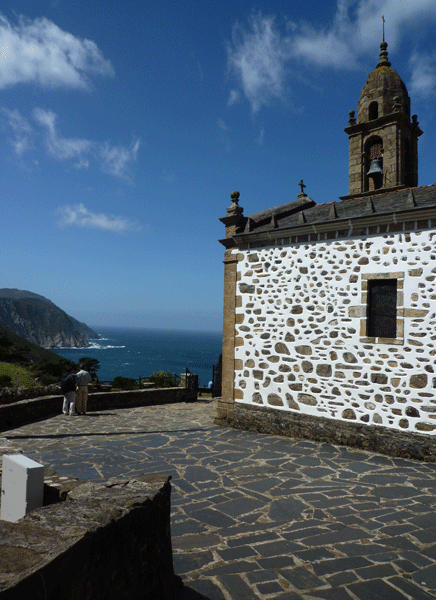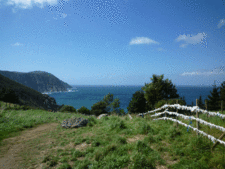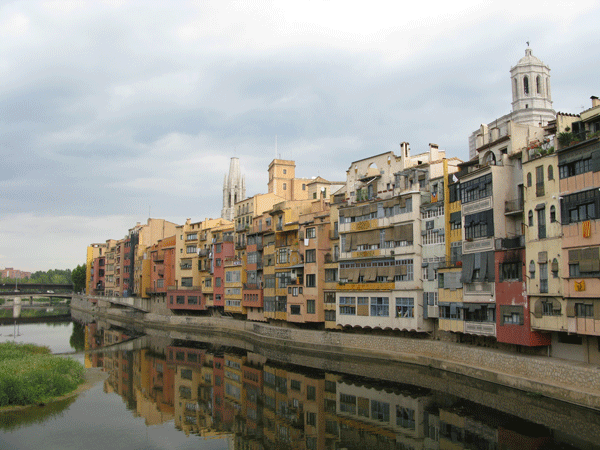words + photos by Elyn Aviva
Souls in the form of lizards and snakes slither their way to the seashore sanctuary of San Andrés de Teixido in northwestern Spain. At least that’s what local Galician folklore claims about this hard-to-reach pilgrimage shrine, perched on a cliff on the Costa da Morte. “If you don’t go there before you die, you’ll have to go there afterwards”—or so the legends assert. So why not go now, I thought to myself? It would certainly be simpler and more convenient. Besides, I was intrigued by these Celtic-tinged stories of transmigration of souls in what appears to be a deeply Catholic country.
 Rather than slither, I went by car, wending my way up and around curvaceous roads shaded by huge eucalyptus trees that swayed in the strong Atlantic breeze. Their medicinal scent filled the air. I pulled over near a TV repeater tower to walk a short stretch of the original pilgrims’ path, careful not to kill any insects I encountered en route—after all, they might be souls on pilgrimage. Or so the legend goes.
Rather than slither, I went by car, wending my way up and around curvaceous roads shaded by huge eucalyptus trees that swayed in the strong Atlantic breeze. Their medicinal scent filled the air. I pulled over near a TV repeater tower to walk a short stretch of the original pilgrims’ path, careful not to kill any insects I encountered en route—after all, they might be souls on pilgrimage. Or so the legend goes.
At last I reached the tiny village of San Andrés and left the car in the large parking lot at the outskirts. I strolled down the narrow lane lined with souvenir stands selling wax ex-votos in the shape of body parts, brightly painted hard-baked bread-dough offerings, and tiny bundles of hierba de enamorar, a local pink flower that is supposed to be a love potion. Something for everyone, I thought. But was there anything here for me?
Around a bend I came to the white-washed sanctuary that guards the relics of the apostle San Andrés (Saint Andrew). The church was surprisingly small, given the size of the folklore that surrounds it. Legend says that San Andrés was distressed because so few pilgrims visited his isolated shrine, so he complained to Christ; Christ felt sorry for him and promised that nobody would enter heaven if they hadn’t gone first to San Andrés de Teixido. It was a great marketing ploy, judging by the popularity of the shrine over the last 400 years.
Many pilgrims come to Teixido to avoid making the journey after they die, but others have different motives. Some come in search of healing or love. Discarded crutches and yellowing wax body parts adorn the steps leading up to the high altar, proof of prayers granted by the saint. Miniature ships reminded me of how close the sea is and how risky the seafarer’s life. A coffin swings from the rafters, an offering from someone who prayed to the saint and avoided death. At least for then.
But there was little to keep me there so I wandered on, following a trail that led to the three-spouted Fountain of the Saint in the shaded grove below. Drink the water or take it home, I was told: it’s holy. They say the flow of the fountain never varies, winter or summer, and that the water issues from beneath the high altar of the sanctuary above. Make a wish, put a piece of bread in the water, and hope that it floats. If it does, your wish is granted. I did and it did, so perhaps it was. Time will tell.
 The path led on. Where, I wondered? I walked faster now, drawn by mystery, pulled by the distant roar of the sea. What’s this? White specks dotted a fence and covered the lower limbs of trees like Christmas flocking. I had seen these clootie cloths draped on trees beside holy wells in Cornwall and Ireland: prayers and promises, hopes of healing, impressed on a piece of cloth or rag and tied around a ready receptacle. But why here? Why so many?
The path led on. Where, I wondered? I walked faster now, drawn by mystery, pulled by the distant roar of the sea. What’s this? White specks dotted a fence and covered the lower limbs of trees like Christmas flocking. I had seen these clootie cloths draped on trees beside holy wells in Cornwall and Ireland: prayers and promises, hopes of healing, impressed on a piece of cloth or rag and tied around a ready receptacle. But why here? Why so many?
I slid through the clootie-covered gate and hurried down the sloping path that led through a meadow, then climbed down a short wooden ladder to another meadow. The sea still called; mystery still drew me on. The path continued. I lowered myself carefully over a low stone wall to yet another steep-pitched meadow. I followed the ever-downward path until it ended abruptly at an impenetrable row of bushes sprinkled with white clootie cloths. Waves blustered and battered against the precipitous cliffs 450 feet below. I had reached the end of the earth. What lay beyond, I wondered, where the sun sank into the vast expanse of sea?
Evergreens beckoned on one side of the meadow, boulders and a grove of gnarled trees on the other. A fresh breeze ruffled the clootie cloths. I took a deep breath and inhaled the scent of sea and pine.
A faint low moan blew through the forest. Was it just the rubbing of branches, I wondered, or had I stumbled on a powerful place—a pagan place of power long before the Christians came and claimed it for their own, building their sanctuary on the hillside high above? The air seemed to vibrate around me. Feeling a little shaky, I walked over to a lichen-covered rock sheltered under twisting trees, and sat down. A lizard scuttled across my feet. I shuddered. Unexpectedly, everything except the sea became very, very still. I held my breath, afraid to look around. It’s not for nothing they call this the “Coast of the Dead,” I thought.
Suddenly the spell broke. Two laughing children and their out-of-breath parents came into sight, hurrying down the path. I watched them for a moment, then slowly stood up, preparing to rejoin the land of the living.
Elyn Aviva is a writer, fiber artist, and transformational traveler. She is fascinated by pilgrimage and sacred sites. Her PhD in anthropology was on the modern Camino de Santiago in Spain. Aviva is co-author of Powerful Places on the Caminos de Santiago, Powerful Places in Scotland, and others in the series. To learn more, go to www.pilgrimsprocess.com and www.fiberalchemy.com
 ✓ If you'd like to subscribe to YourLifeisaTrip.com and be notified when new articles appear, click here. It's free, it's fun, and it keeps you on the cutting edge of what our writers are thinking.
✓ If you'd like to subscribe to YourLifeisaTrip.com and be notified when new articles appear, click here. It's free, it's fun, and it keeps you on the cutting edge of what our writers are thinking.


